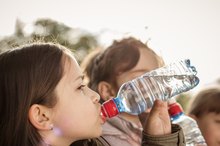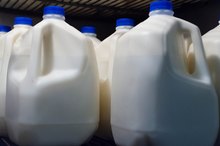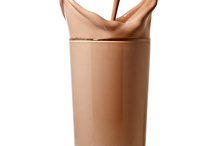What does fact checked mean?
At Healthfully, we strive to deliver objective content that is accurate and up-to-date. Our team periodically reviews articles in order to ensure content quality. The sources cited below consist of evidence from peer-reviewed journals, prominent medical organizations, academic associations, and government data.
- PubMed Central: "Journal of the International Society of Sports Nutrition": International Society of Sports Nutrition Position Stand: Protein and Exercise
- PubMed Central: "Journal of the International Society of Sports Nutrition": International Society of Sports Nutrition Position Stand: Protein and Exercise
- Nutrition and Metabolism: Effect of Protein/Essential Amino Acids and Resistance Training on Skeletal Muscle Hypertrophy: A Case for Whey Protein
- Pubmed Central: "Nutrition Journal": Soy Versus Whey Protein Bars: Effects on Exercise Training Impact on Lean Body Mass and Antioxidant Status
- Pubmed Central: "Nutrition Journal": Soy Versus Whey Protein Bars: Effects on Exercise Training Impact on Lean Body Mass and Antioxidant Status
- PubMed Central: "The Journal of Physiology": Timing of Postexercise Protein Intake Is Important for Muscle Hypertrophy with Resistance Training in Elderly Humans
- PubMed Central: "The Journal of Physiology": Timing of Postexercise Protein Intake Is Important for Muscle Hypertrophy with Resistance Training in Elderly Humans
The information contained on this site is for informational purposes only, and should not be used as a substitute for the advice of a professional health care provider. Please check with the appropriate physician regarding health questions and concerns. Although we strive to deliver accurate and up-to-date information, no guarantee to that effect is made.
Milk & Yogurt Vs. Protein Shakes for Muscle Development
According to the International Society of Sports Nutrition, or ISSN, protein helps the body build muscle, helps muscles replenish energy stores after intense bouts of exercise, and helps keep the body from breaking down existing muscle and bone 1. Milk, yogurt and protein shakes all provide this nutrient. Which type you choose depends on your personal preference regarding taste, calories, convenience and cost.
Recommendations
The ISSN recommends that active people try to get their protein through whole foods sources like milk and yogurt, but if they do choose to use supplements like protein powders, that they look for products with both whey and casein—both derived from milk—because this type of protein appears to be easier for the body to absorb and use for building muscles.
Performance
Protein Shakes Before or After a Workout for Weight Loss?
Learn More
In 2007, Joseph Hartman and others published research results in the “American Journal of Clinical Nutrition” showing that drinking liquid milk after weightlifting was effective in helping young males build muscle. Another review in “Nutrition and Metabolism” in 2010 argued that whey protein worked best 2.
Nutrition
Most protein powders are made of whey and casein, both of which come from milk. The powders offer a concentrated form of milk protein, providing about three or four times as much protein as a glass of milk or cup of yogurt. However, they do not contain the other nutrients found in milk, like calcium and vitamin D. Because of the high protein value, a shake will have several times more calories than a serving of milk or yogurt. Both flavored yogurts and shakes can also contain either added sugar or artificial sweeteners.
- Most protein powders are made of whey and casein, both of which come from milk.
Convenience
Benefits of Drinking Muscle Milk Before Sleep
Learn More
If milk or yogurt is your post-workout protein snack of choice, you will probably have to pack and take it with you in a cooler.
Your gym might sell bottled premixed protein shakes. If they do, be sure to read the nutritional label and understand exactly what’s in that beverage. Many drinks contain sugar, caffeine and herbal additives. There is no conclusive research indicating that the extras help muscle recovery or development, but they might upset your stomach or interfere with your body’s ability to absorb the fluids and protein it needs.
Gyms with a juice stand provide you with a convenient option to pick up a freshly blended protein shake right after your workout, which is the best time to refuel. Just be sure you know exactly what’s going into your shake.
- If milk or yogurt is your post-workout protein snack of choice, you will probably have to pack and take it with you in a cooler.
- Gyms with a juice stand provide you with a convenient option to pick up a freshly blended protein shake right after your workout, which is the best time to refuel.
Cost
At a dollar or less per serving, milk and yogurt are the low-cost leaders for post-workout refueling.
Bottled and freshly blended protein shakes cost about four dollars each. Bulk containers of protein powders are more cost-effective than individual shakes, but those big tubs still carry a hefty price tag.
Until a clear answer emerges about the optimal blend of nutrients, use the option that works best for you, while always keeping a watchful eye on ingredient lists and nutritional information.
- At a dollar or less per serving, milk and yogurt are the low-cost leaders for post-workout refueling.
Related Articles
References
- PubMed Central: "Journal of the International Society of Sports Nutrition": International Society of Sports Nutrition Position Stand: Protein and Exercise
- Nutrition and Metabolism: Effect of Protein/Essential Amino Acids and Resistance Training on Skeletal Muscle Hypertrophy: A Case for Whey Protein
- Pubmed Central: "Nutrition Journal": Soy Versus Whey Protein Bars: Effects on Exercise Training Impact on Lean Body Mass and Antioxidant Status
- PubMed Central: "The Journal of Physiology": Timing of Postexercise Protein Intake Is Important for Muscle Hypertrophy with Resistance Training in Elderly Humans
Resources
Writer Bio
Valerie Webber started out as a technical writer in 1994 and transitioned into journalism in 2004. Her work has appeared in “The Gainesville Times,” “The Fauquier Times-Democrat,” “Merial Selections” and “SIDEROADS” magazine. Webber is also certified by the American Council on Exercise as a group fitness instructor.









